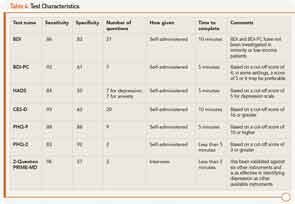Caracciolo and Giaquinto studied patients with neurological and orthopedic conditions receiving rehabilitation because depression is quite common in patients receiving these services.25 They chose to use the CES-D because it has good psychometric properties among patients with a variety of medical conditions and found it was appropriate for use with older adults and patients who are ill. In their study of patients with orthopedic conditions, including fractures and joint arthroplasties, the CES-D had a sensitivity of 100% with a specificity of 57%. The rates were almost identical for patients with neurological conditions.
The Patient Health Questionnaire (PHQ-9) is a nine-question tool that can be completed by patients in a few minutes. It can be administered by the clinician, via self-report or over the phone. The nine questions of this screen were selected because they asked for the symptoms of depression as identified in the DSM-IV. Like several other tools, it provides a score of 0–3 for each item, but asks the patient to identify how often the symptom is present rather than how severe the symptom is. There are check-off boxes for “not at all” (0) to “nearly every day” (3). A scoring rubric is provided for the examiner, which can be completed in a few minutes and can rate a patient’s level of depression from minimal to severe.
Two symptoms on the PHQ-9 are more significant than others. They ask if over the past two weeks the patient has been bothered by any of the following problems: “Little interest in doing things” and/or “Feeling down, depressed or hopeless.”27,28 One or both of these questions must be present for more than half the days or nearly every day in order to screen positive for depression.27,28 In addition to symptoms being present, they must cause distress in social, occupational or other areas that are of importance to the patient. As the frequency of the depressive symptoms increases, patients are less able to function in daily life skills, used more sick days from work and used the healthcare system more frequently. For this reason, a 10th question asks the patient who has checked any box that is greater than 0 to indicate how difficult this symptom made it for the patient to work, take care of things at home or get along with people. The response to this item alone is an excellent marker for functional impairment.27,28

